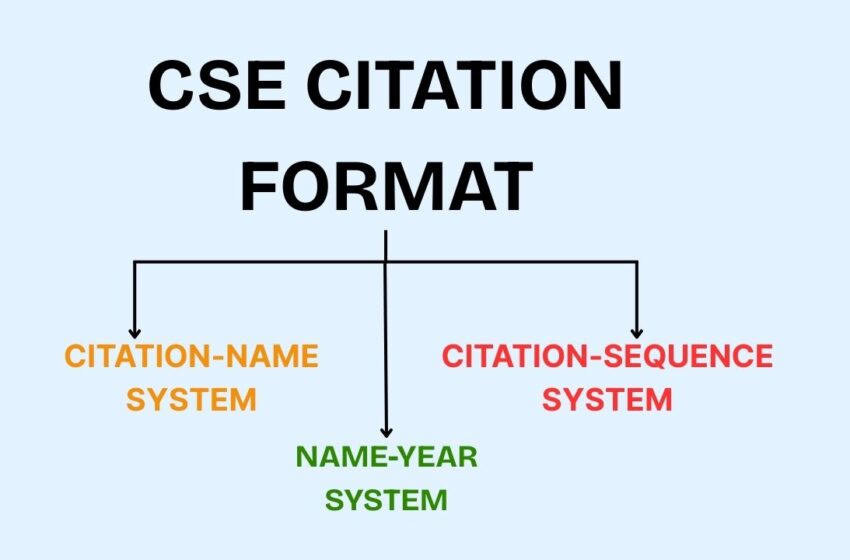CSE Citation Style Formatting Guide for Manuscripts

What is CSE Format?
The Council of Science Editors (CSE) style guide is a manual that provides guidelines for formatting scientific writing. Although initiated in the 1960s as a style guide for biology journals, the CSE format has evolved over the years and now encompasses various science fields.
General Guidelines of CSE Format
CSE format recommends referring to the journal or publisher guidelines for a more specific style guide. However, here are some general guidelines to follow when your paper uses CSE formatting.
- All paragraphs in the main text must be left-aligned. The first sentence should be indented by five spaces.
- A standard font such as Times New Roman (12 pt) is preferred.
- Page margins should be 1-inch on all sides.
- The manuscript must be double-spaced, including the title page and the reference list.
- The header should include the page number on the right-hand side. The title page should not be numbered.
- All information on the title page (e.g., the title of the paper, course and university details, your name, the instructor’s name, and date of submission) must be centered.
- The headings and sub-headings in the manuscript should be of the same font and size as that used in the text.
- In-text citations can be documented in three styles: (i) citation-sequence, (ii) citation-name, and (iii) name-year formats.
Citation Guidelines of CSE Style
When citing references in the CSE format, you may use one of the three styles as recommended by your instructor, journal, or publisher. A list of references should be provided at the end of the document in the required format depending on the style followed.
In the reference list, the authors should be listed first followed by the article title. The journal title comes next, which should be abbreviated without periods (e.g., J Mol Liq). The date and volume should be separated by a semicolon, and the DOI-based URL should be mentioned wherever available.
Citation-Sequence System
In the citation-sequence format, the references should be listed in the order of their appearance in the main text. The numbered in-text citations are written as superscripts and placed before the punctuation.
Example: The results reported confirmed the initial hypothesis1.
Citation-Name System
The format of the citation-name system is similar to that of the citation-sequence system, except that the references in the list are arranged in alphabetical order. This means that the numbered in-text citations of the corresponding work in the main text may not be in sequential order.
Example: If a work by “Catherine” is numbered 6 on the list, each in-text reference to Catherine is written as 6 regardless of where it appears in the main text.
Below are the format and examples of how different types of works should be written in the reference list under both citation-sequence and citation-name systems.
| Format | Example | |
| Journal article | Author(s). Article title. Abbreviated journal title. Date;volume(issue):location. URL | Koopmans RJ, Shrimpton JS, Roberts GT, Musker AJ. Dependence of pellet shape and size on pressure drop in H2O2 thrusters. J Propul Power. 2014;30(3):775–789. https://doi.org/10.2514/1.B35072 |
| Book | Author(s). Title. Edition. Publisher; year of publication. | Davis NS, McCormick JC. Design of catalyst packs for the decomposition of hydrogen peroxide, Liquid Rockets and Propellants. Academic Press; 1960. https://doi.org/10.2514/5.9781600864759.0589.0616 |
| Website | Author. Title of the article. Publisher; date of publication [date accessed or date updated (if applicable)]. URL | McCormick J. Hydrogen Peroxide Rocket Manual. FMC Corporation; 1965 [accessed 2024 Jun 13]. https://mae-nas.eng.usu.edu/Peroxide_Web_Page/documents/AFRL_TR_67_144.pdf |
Name-Year System
The name-year format requires you to mention the surname of the author and the publication year of the work when citing references in the main text. The reference list is unnumbered and written in alphabetical order. If there are multiple works by the same author, the references are listed chronologically.
Examples
One author: The analysis confirmed the absence of oxidation (Llamar 1998).
Two authors: There have been reports of Giant Antpitta sightings in Ecuador (Cupp and Presley 2013), but they are not common in the Amazon rainforest.
Three or more authors: The findings confirmed significant improvement in the speed of the vehicle (Leeman et al 2023).
When listing the works in the reference list, note that the publication year should be placed after the author names. The remaining information is written in the same format as that followed for the citation-name and citation-sequence systems.
| Format | Example | |
| Journal article | Author(s). Date. Article title. Abbreviated journal title. Volume(issue):location. URL | Koopmans RJ, Shrimpton JS, Roberts GT, Musker AJ. 2014. Dependence of pellet shape and size on pressure drop in H2O2 thrusters. J Propul Power. 30(3):775–789. https://doi.org/10.2514/1.B35072 |
| Book | Author(s). Date. Title. Edition. Publisher. | Davis NS, McCormick JC. 1960. Design of catalyst packs for the decomposition of hydrogen peroxide, Liquid Rockets and Propellants. Academic Press. https://doi.org/10.2514/5.9781600864759.0589.0616 |
| Website | Author. Date. Article title. Publisher; [date accessed or date updated (if applicable)]. URL | McCormick J. 1965. Hydrogen Peroxide Rocket Manual. FMC Corporation; [accessed 2024 Jun 13]. https://mae-nas.eng.usu.edu/Peroxide_Web_Page/documents/AFRL_TR_67_144.pdf |
Give more time for your research, spend less time formatting! Check out Editage’s Manuscript Formatting Services and get professional support for journal formatting.









